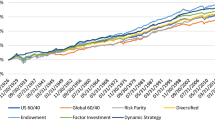Abstract
The objective of this article is to offer further investigation of the practice of investors to concentrate their investments in cash or bonds as they grow older, and their investment horizons decrease. To provide evidence in this regard, we assess the impact of investment horizon by computing returns, risks and end-of-period wealth distributions of the major UK asset classes, over increasing time horizons. We use monthly observations between 1963 and 2005, and our assessment is based on a block bootstrapping technique. This methodology offers an improvement on previous studies, as it facilitates the retention of past time series patterns of returns. It is likely that these patterns will continue into the future. Results show that investment outcomes at short horizons are different to outcomes at longer horizons. Evidence is provided in favour of time diversification, up to a 5-year horizon. Further, we find that the probability of ending with a shortfall in end-of-period wealth decreases as the holding period lengthens. We also find that higher risk asset classes outperform lower risk asset classes and have higher end-of-period wealth for longer holding periods.
Similar content being viewed by others
Notes
Global Financial Data for January 2000.
These data were supplied by FTSE.
These data were supplied by ABN AMRO.
The source for both sets of yield series is the Bank of England.
We thank Shane Whelan for this suggestion. Full details regarding the estimation of monthly returns from Long Bond yield data are available from the authors.
A general description of the bootstrap re-sampling technique can be found in Efron (1979).
Cross-correlations for other pairs of asset classes, such as SMALL versus TBOND and ALL versus TBILL, which are not reported in Table 3, show that these asset classes are not significantly correlated.
Basic bootstrap results are available from the authors. They have not been included, because of space constraints.
Although this may be surprising and counter-intuitive, it is consistent with the findings in Hatch and White (1989), who examine relative returns over a much shorter holding period.
Basic bootstrap statistics on the distribution of end-of-period wealth are available from the authors.
Again, because of space constraints, figures from a basic bootstrap also have not been included. They are available from the authors.
References
Alles, L. and Athanassakos, G. (2006) The effect of investment horizons on risk, return and end of period wealth for major asset classes in Canada. Canadian Journal of Administrative Sciences 23 (2): 138–152.
Bodie, Z. (1995) On the risk of stocks in the long run. Financial Analysts Journal 51 (3): 18–22.
Booth, L. (2004) Formulating retirement targets and the impact of time horizon on asset allocation. Financial Services Review 13 (1): 1–17.
Butler, K. and Domian, D. (1991) Risk, diversification and the investment horizon. Journal of Portfolio Management 17 (3): 41–48.
Dimson, E., Marsh, P. and Staunton, M. (2002) Triumph of the Optimists: 101 Years of Global Investment Returns. Princeton, NJ: Princeton University Press.
Efron, B. (1979) Bootstrap methodology: Another look at the Jacknife. Annals of Statistics 7 (13): 1–26.
Hatch, J. and White, E. (1989) Anatomy of a stock market crash: The case of October 1987. Canadian Investment Review 2 (1): 6–18.
Hickman, K., Hunter, H., Byrd, J., Beck, J. and Tempering, W. (2001) Life cycle investing, holding periods and risk. Journal of Portfolio Management 27 (2): 101–111.
Kritzman, M. (1994) About time diversification. Financial Analysts Journal 50 (1): 14–18.
Lo, A. and MacKinlay, A. (1988) Stock market prices do not follow random walks: Evidence from a simple specification test. Review of Financial Studies 1 (1): 41–66.
Olsen, R. and Khaki, M. (1998) Risk, rationality and time diversification. Financial Analysts Journal 54 (5): 58–63.
Samuelson, P. (1963) Risk and uncertainty: A fallacy of large numbers. Scientia 98 (2): 108–113.
Strong, N. and Taylor, N. (2001) Time diversification: Empirical tests. Journal of Business Finance and Accounting 28 (3&4): 263–302.
Author information
Authors and Affiliations
Corresponding author
Rights and permissions
About this article
Cite this article
Alles, L., Murray, L. Investment performance and holding periods: An investigation of the major UK asset classes. J Asset Manag 10, 280–292 (2009). https://doi.org/10.1057/jam.2009.16
Received:
Revised:
Published:
Issue Date:
DOI: https://doi.org/10.1057/jam.2009.16




